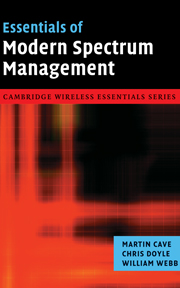Book contents
- Frontmatter
- Contents
- Acknowledgements
- I Emerging problems with the current spectrum management approach
- II Markets
- III Regulation
- 11 Incentive based spectrum prices: theory
- 12 Incentive based spectrum pricing: practicalities
- 13 How the commons works
- 14 Commons or non-commons?
- 15 Is public sector spectrum management different?
- 16 Are developing countries different?
- IV Conclusions
- Further reading
- Abbreviations
- Author biographies
- Subject index
- References
13 - How the commons works
Published online by Cambridge University Press: 13 August 2009
- Frontmatter
- Contents
- Acknowledgements
- I Emerging problems with the current spectrum management approach
- II Markets
- III Regulation
- 11 Incentive based spectrum prices: theory
- 12 Incentive based spectrum pricing: practicalities
- 13 How the commons works
- 14 Commons or non-commons?
- 15 Is public sector spectrum management different?
- 16 Are developing countries different?
- IV Conclusions
- Further reading
- Abbreviations
- Author biographies
- Subject index
- References
Summary
Introduction
The “commons” is a part of the spectrum where anyone can transmit without a licence. For that reason it is sometimes called licence-exempt or unlicensed spectrum.
Unlicensed spectrum was until recently of little interest. However, since the late 1990s it has been debated more widely. This has been caused by the following developments.
Deployments of new technologies in the 2.4 GHz band, particularly of Wi-Fi, have been very successful, leading many to ask whether further unlicensed allocations would result in more innovation and deployments.
The development of ultra-wideband (UWB) and the promise of cognitive radio have led some to question whether these technologies can overcome historical problems with unlicensed spectrum.
The debate around the role of unlicensed spectrum has been particularly intense in the USA, where the term “spectrum commons” has come to be used to advocate an approach where much more of the spectrum is unlicensed. Advocates have suggested concepts such as radios seeking temporarily unused spectrum, making short transmissions and then moving onto other unused bands. Some of these concepts extend beyond unlicensed spectrum and into property rights and many of these issues were discussed in Chapter 7.
There is little agreement as to the optimal relative amount of spec-trum assigned to unlicensed as against licensed usage. There are also many hybrid suggestions. For example, it has been suggested that spectrum be unlicensed but users have to pay a fee to access it depending on the current level of congestion.
- Type
- Chapter
- Information
- Essentials of Modern Spectrum Management , pp. 203 - 222Publisher: Cambridge University PressPrint publication year: 2007



